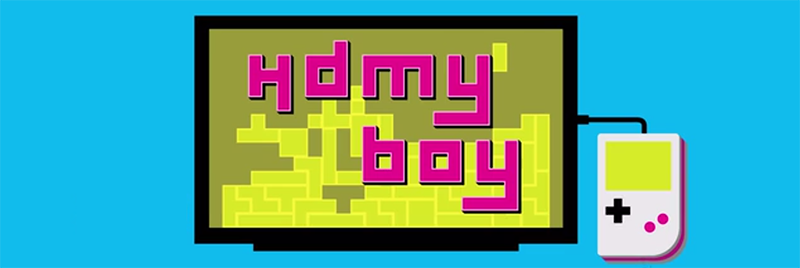A few years ago, some vastly clever people figured out how to listen in on the LCD display on the classic brick Game Boy from 1989. There have been marked improvements over the years, including a few people developing VGA out for the classic Game Boy. Now, the bar has been raised with an HDMI adapter for the Game Boy, designed in such a way that turns everyone’s favorite battery hog into a portable console.
Your classic beige or cleverly named Color Game Boy is composed of two halves. The rear half contains all the important circuitry – the CPU, cartridge connector, and the rest of the smarts that make the Game Boy game. The front half is fairly simple in comparison, just an LCD and a few buttons. By designing an adapter that goes between these two halves, [Zane] and [Joshua] were able to stuff enough circuitry inside the Game Boy to convert the signals going to the LCD to HDMI. Plug that into your TV, and you have a huge modern version of the Super Game Boy, no SNES required.
The HDMIBoy also breaks out the buttons to the classic NES controller connector. With HDMI out and a controller input, the old-school Game Boy become a portable if somehow even more brick-like console.
















This is a pretty neat idea, I have a couple old brick Gameboys sitting in a drawer and I’d consider picking one of these up if it wasn’t so pricey. A DIY option would be cool, especially considering this thing probably isn’t going to gain much appeal beyond the most hardcore of Gameboy enthusiasts.
Considering that you will need a fairly chunky FPGA to do the HDMI out, the price they are asking for is fairly low. If you do a DIY version, it would likely end up more expensive – the FPGA ($20-40 at least), potentially some HDMI interface stuff (if the FGPA doesn’t have it built-in), 4 layer board (likely $40+ for one off), FPGA programming adaptor (usually vendor-specific JTAG cable – another $20+), enclosure, … It adds up quickly. Moreover, you would likely face the soldering of a nasty BGA package if you wanted to have any chance to actually fit the board inside of the GB – FPGAs don’t come in small and easy to solder packages, 100+ pin TQFPs are huge and the other choice are BGAs.
This really is a project that is viable only if it is produced in volume, one offs would be very expensive.
Neat, however there are very few details on the solution used, what chips are being used by example ?
Is it an fpga, an ASIC ? Having DIY info about generatng HDMI would be awesome.
Likely an FPGA at this point – there is the photo with the prototype having an enormous TQFP on top and then another shot having two chips there – likely an SDRAM and some microcontroller or FTDI JTAG for programming.
ASIC is very expensive to do, completely out of question for prototypes/small runs.
General HDMI generation information is available:
http://www.fpga4fun.com/HDMI.html
or
http://hamsterworks.co.nz/mediawiki/index.php/Spartan_6_1080p
A specific ASIC, yes ; but maybe a generic, lowspec, affordable hdmi asic encoder does exist, like there are some simple LCD driver chip (eve800, ILIxxx, …)
Or you can use Flat Panel transmitter (e.g. TI’s TFP410 – ~ $11 QTY 1 $4.50 QTY 1000). It can generate up to TDMS 1080p DVI signals. It comes in thermal enhanced TQFP64 package.
If you are doing 480p low res display, a regular FPGA with DDR I/O should be able to do the encoding (without a built-in SERDES). You would need to convert the output voltage level to one that is DVI/HDMI compatible.
[SPAM] sort of
Maybe I need to come out sooner as I would like. D I don’t have everything prepared yet.
I will in 2-3 months offer VGA and composite out.
and separate rf controller (sold if wanted)
You can change color and composite is for NTSC and PAL
YT video
https://www.youtube.com/watch?v=HGje7a6_1Jk
3d model
https://db.tt/8nRCrfFS
Well will see how this goes. If there is still interest :)
for about 100 us bucks
While it’s an interesting hack it isn’t at all practical. You already have two really good options for playing a Gameboy on your big screen… the super Gameboy and the gamecube gba player. Both allow for external controllers, both use augmented Gameboy color additions to the game and both allow for rgb out (although admittedly the gamecube cables can be pricey). RGB out is native analog signal with no compression so it can easily and inexpensively be converted to vga or hdmi with a simple adaptor.
So you can essentially rig up a snes to do this for well under the asking price and you won’t have to add an additional 2 inches to the girth of your Gameboy.
you forgot the best option of them all – emulator on your _phone_ + ezcast/chromecast/miracast
Except that the Super Game Boy was more than an I/O adapter, it allowed access to extra features of the SNES (more keypads, colors, more sprites, sound effects, ability to run arbitrary code on the SNES CPU).